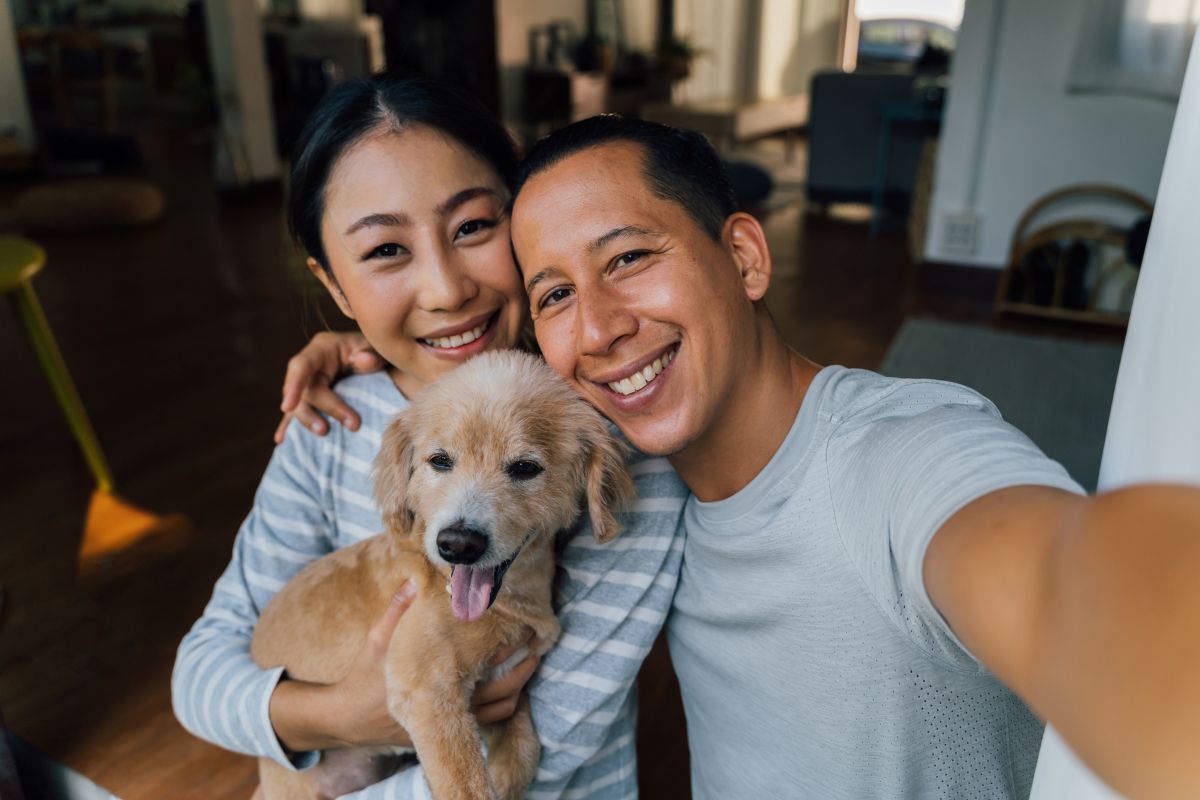Please create a free account, or login by clicking here.
Petland Gahanna, Ohio


Status
Available
Reference ID
249
Availability
04-15-2025
Birth Date
02-12-2025
Age
9 Weeks 4 Days
Gender
Female
Color
Black / Tan
Location
Petland Gahanna
Breed: French Bulldog
Pet ID: 25624-02
Color: Black / Tan
The one-of-a-kind French Bulldog, with his large bat ears and even disposition, is one of the world’s most popular small-dog breeds, especially among city dwellers. The Frenchie is playful, alert, adaptable, and completely irresistible.
The French Bulldog resembles an English Bulldog in miniature, except for the large, erect ‘bat ears’ that are the breed’s trademark feature. The head is large and square, with heavy wrinkles rolled above the extremely short nose. The body beneath the smooth, brilliant coat is compact and muscular. The bright, affectionate Frenchie is a charmer. Dogs of few words, Frenchies don’t bark much, but their alertness makes them excellent watchdogs. They happily adapt to life with singles, couples, or families, and do not require a lot of outdoor exercise. They get on well with other animals and enjoy making new friends of the human variety. It is no wonder that city folk from Paris to Peoria swear by this vastly amusing and companionable breed.
Also known as the “Frenchie,” French Bulldogs were first bred in the 1800s in Nottingham by lace makers. The intentions were to breed a miniature version of the English Bulldog. By the mid-1800’s this breed arrived in France and has been popular since. French Bulldogs have climbed the charts in the dog world and were recently recognized as the second-most popular registered dog in the United Kingdom, and the fourth-most popular AKC-registered dog breed in the United States.
The bright, affectionate Frenchie is a charmer. Dogs of few words, Frenchies don’t bark much, but their alertness makes them excellent watchdogs. They happily adapt to life with singles, couples, or families, and do not require a lot of outdoor exercise. They get on well with other animals and enjoy making new friends of the human variety. It is no wonder that city folk from Paris to Peoria swear by this vastly amusing and companionable breed.
The one-of-a-kind French Bulldog, with his large bat ears and even disposition, is one of the world’s most popular small-dog breeds, especially among city dwellers. The Frenchie is playful, alert, adaptable, and completely irresistible.
The French Bulldog resembles a Bulldog in miniature, except for the large, erect ‘bat ears’ that are the breed’s trademark feature. The head is large and square, with heavy wrinkles rolled above the extremely short nose. The body beneath the smooth, brilliant coat is compact and muscular.
French Bulldogs are typically seen in a short coat variety but there is a “fluffy” variation that comes from the presence of the “fluffy” gene in both mother and father.
The Frenchie’s short coat sheds minimally. Weekly brushing with a medium-bristle brush, a rubber grooming mitt or tool, or a hound glove will help to remove shed hair and keep him looking his best. Brushing promotes new hair growth and distributes skin oils throughout the coat to help keep it healthy. A Frenchie’s facial folds should be kept clean and dry. The Frenchie’s nailsshould be trimmed regularly, as overly long nails can cause him pain.
A short walk or outdoor play session with their owner each day should provide enough exercise to keep the French Bulldog in shape. Frenchies enjoy participating in canine sports such as obedience, agility, and rally. As a flat-faced breed, however, they are prone to breathing difficulties and should never be allowed to exert themselves in hot or humid weather.
Early socialization and puppy training classes are recommended. Exposing the puppy to a wide variety of people, places, and situations will help him develop into a well-adjusted adult. Puppy training classes serve as part of the socialization process, promote good behavior, and help the owner learn to recognize and correct bad habits. Frenchies have big personalities and can need a fair amount of training to make them civilized companions. They can be stubborn, but at heart they’re people pleasers and therefore easy to train. The proper motivation (such as food) and making a game of the process will ensure their cooperation.
A high-quality dog food appropriate to the dog’s age (puppy, adult, or senior) will have all the nutrients the breed needs. Frenchies are prone to obesity, which can damage their physical structure and puts them at higher risk for some of the breed’s health issues, so it is vital to watch their calorie intake and weight. If you choose to give your dog treats, do so in moderation. Give table scraps sparingly, if at all, especially avoiding cooked bones and foods high in fat. Learn about which human foods are safe for dogs and which are not. Check with your vet if you have any concerns about your dog’s weight or diet.
This breed has an average life expectancy of ten to twelve years.
Although spaying or neutering is not compulsory, it is highly advisable to spay your French Bulldog. This will help to decrease its chances of getting certain kinds of cancer. It also prevents the risk of unwanted breeding between your French Bulldog and any nearby dog.
French Bulldogs are non-aggressive dogs who like to stay near their owner. Frenchies have big personalities and can need a fair amount of training to make them civilized companions. They can be stubborn, but at heart they’re people pleasers and therefore easy to train. The proper motivation (such as food) and making a game of the process will ensure their cooperation.
With a proper diet and nutrition, French Bulldogs can live for up to eleven or thirteen years.
Yes. French Bulldogs can eat raw meat such as chicken, liver or kidney. The safest way to provide raw food as part of a dog’s diet is to use a commercially prepared frozen raw diet such as Tuckers, Primal, or Stella and Chewy’s. Canned dog food is a good alternative to raw, and there are many quality dry food options.
French Bulldogs and English Bulldogs are quite similar but have key differences. English bulldogs are bigger, heavier, and less athletic while the French Bulldog is considerably smaller and moves with more agility. French Bulldogs also have upright pointy ears whereas the English breed has folded ears.
Just like all other breeds, French Bulldogs can get fleas. If they do get fleas, this can be solved by getting flea medicine or using a flea comb to get rid of the fleas.
French Bulldogs can be prone to separation anxiety. Creating a predictable schedule for your Frenchie where there is regular crate time and regular time with members of the family can help.
Crate training is one of the best ways to train your French Bulldog. Crate training fills the instinctive need for a den and creates a safe “home base” for you puppy to call its own. The crate must be properly sized during training so the puppy does not have too much space otherwise accidents in the crate will be a more frequent occurrence. French Bulldogs are food-motivate and respond well to positive reinforcement.
Dogs should always be supervised around young children, or children of any age who have little exposure to dogs. French bulldogs are generally fairly patient with children and have a family friendly nature. It is important to help your French bulldog form good family habits while they are young. French Bulldogs need to chew and owners need to provide a variety of items for the puppy to chew on that are puppy safe and appropriate. It is also important to teach children how to interact with their Frenchie puppy safely.
The French Bulldog is about 11 or 12 inches tall and weighs an average of 16-28 pounds.
Mother - Dam
Father - Sire

So, you’re thinking about getting a puppy from Petland? Get ready because you’re not just taking home a bundle of furry joy. You’re also getting a full-on star...

Bringing home a new puppy is like adding a little tornado of energy to your life. They zoom around, chew on everything, and look at you with those big, eager eyes that say, R...

Bringing a dog into your family is a big decision that comes with lots of joy, responsibility, and, of course, plenty of tail wags. With so many breeds to choose from, finding t...
Image Not Found
So, you’ve decided to add a four-legged best friend to your life—congrats! But now comes the hard part… which breed is right for you? Choosing a dog isn’...

Bringing home a new puppy? Get ready for cuteness overload, lots of tail wags, and… a bit of chaos too. Puppies are like tiny, adorable tornadoes that can turn your world ...

Self-care is all about wagging your tail and feeling pawsitively great! It involves activities that keep you happy, healthy, and full of energy. Whether it’s a daily walk,...

Bringing a puppy into your life is like welcoming a furry little tornado of joy, energy, and endless cuteness. But let’s be real—along with the cuddles and wagging t...

As a cat owner, ensuring the health and safety of your furry friend is a top priority. With the emergence of avian influenza, commonly known as bird flu, it’s crucial to u...

Ah, Christmas! The time of year when homes are aglow with twinkling lights, the air is filled with the scent of pine, and everyone is wrapped in a warm, fuzzy feeling of joy and...

There’s nothing like the joy of bringing a fluffy, four-legged bundle of joy into your life. Puppies are the ultimate companions—full of love, energy, and just a lit...

1. Thanksgiving: The Feast of Gratitude and Gravy Thanksgiving is the time to shine brighter than a disco ball in the holiday hall of fame. It’s when families roll in like...
Image Not Found
Ensuring the well-being of your pets is not just about providing food and shelter; it’s about understanding their needs at every life stage and offering a holistic approac...
